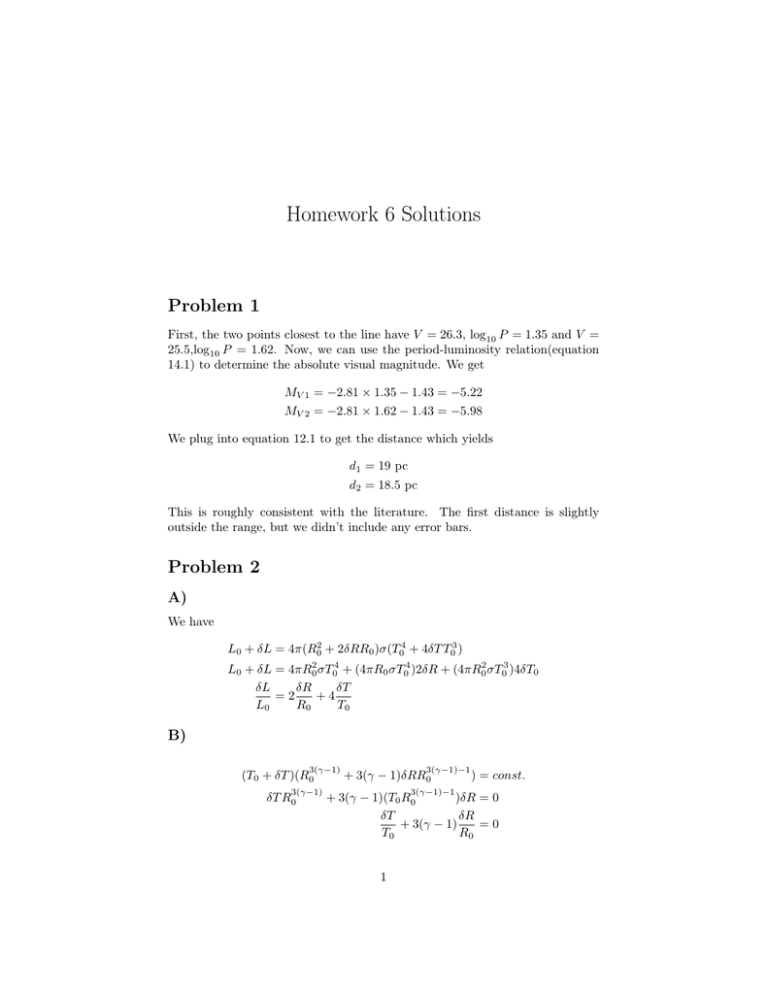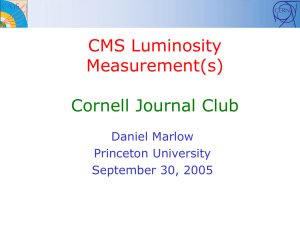Homework 6 Solutions Problem 1
advertisement

Homework 6 Solutions Problem 1 First, the two points closest to the line have V = 26.3, log10 P = 1.35 and V = 25.5,log10 P = 1.62. Now, we can use the period-luminosity relation(equation 14.1) to determine the absolute visual magnitude. We get MV 1 = −2.81 × 1.35 − 1.43 = −5.22 MV 2 = −2.81 × 1.62 − 1.43 = −5.98 We plug into equation 12.1 to get the distance which yields d1 = 19 pc d2 = 18.5 pc This is roughly consistent with the literature. The first distance is slightly outside the range, but we didn’t include any error bars. Problem 2 A) We have L0 + δL = 4π(R02 + 2δRR0 )σ(T04 + 4δT T03 ) L0 + δL = 4πR02 σT04 + (4πR0 σT04 )2δR + (4πR02 σT03 )4δT0 δR δT δL =2 +4 L0 R0 T0 B) 3(γ−1) (T0 + δT )(R0 3(γ−1) δT R0 3(γ−1)−1 + 3(γ − 1)δRR0 + 3(γ − ) = const. 3(γ−1)−1 1)(T0 R0 )δR =0 δT δR + 3(γ − 1) =0 T0 R0 1 Substituting γ = 5/3 we get δT δR +2 =0 T0 R0 δT δR = −2 T0 R0 Plugging in we get δL δR = −6 L0 R0 Problem 3 A) We can use equation 12.1 to calculate the absolute visual magnitude with the extinction included. The answer is −13.5, which gives us a luminosity of 2 × 107 Ls . B) If we take the above luminosity and multiply by 20 years we get E = 4.8 × 1042 J C) K= 1 3Ms (650000)2 = 1.27 × 1042 J 2 Problem 4 The gravitational energy from the core that can be converted to kinetic energy is given by(remember the virial theorem!) 3GM 2 10R Then, the total energy that goes into the ejecta is 3 1 1 (.01)GMs2 − 10 Rf Ri E=− The energy needed to completely eject the remaining 9 solar masses is just the gravitational energy 9GMs2 R̃ Where R̃ is the average radius. Some algebra yields 1 3000 1 = + rf Ri R̃ 2 Problem 5 A) Conservation of angular momentum requires that the ratio of the periods equal the squared ratio of the radii. 2 10000 P = Ps = 4.6 × 10−4 s RS B) The ratio of magnetic field strength is the inverse ratio of radii. B = Bs 10000 Rs 2 ≈ 106 T Problem 6 A) The minimum period is given by s P = 2π 100003 1.4GMs Plugging in we get P = 4.6 × 10−4 s. B) We need to solve the two equations E + P = 2R = 20000 m E−P = 5Ω2 R4 = 9.45 × 10−22 = 3122 m 4GM We end up with E = 11.56 km P = 8.44 km Problem 7 A) 250 parsecs 3 B) L = 4πR2 σT 4 = 7.125 × 1025 W = .19Ls C) λmax = b = 28.98 angstroms T D) We just need to plug the wavelengths into Planck’s law with the temperature at 106 Kelvins and divide. The ratio comes out to 4 × 106 . E) v= 2π ∗ 10000 = 17781.4m/s .283 Problem 8 A) The derivation can be found on page 662 of the text. Starting with the formula for the total energy of the gas orbiting the primary star E = −G M1 m r We are then asked to consider a thin ring at radius r and with width dr, Ṁ is the rate at which mass enters the ring. We assume that no mass accumulates in the ring, so the rate at which mass enters the ring is equal to the rate it exits. In any given time the energy radiated from the ring is equal to the difference in energy of the mass entering and leaving the ring. dE = dE M1 Ṁ t dr = G dr dr r2 Then, the luminosity is given by dL = dE/t. We integrate from R to infinity to get the answer. B) We use the equation LEdd = 1.26 × 1031 M = 1.89 × 1031 W Ms 4 C) We have the equation GṀ M = 4πR2 σT 4 R = 4094Ṁ 1/4 For Ṁ measured in kilograms per second. At the Eddington Luminosity the temperature would be 2.27 × 107 Kelvins. 5











